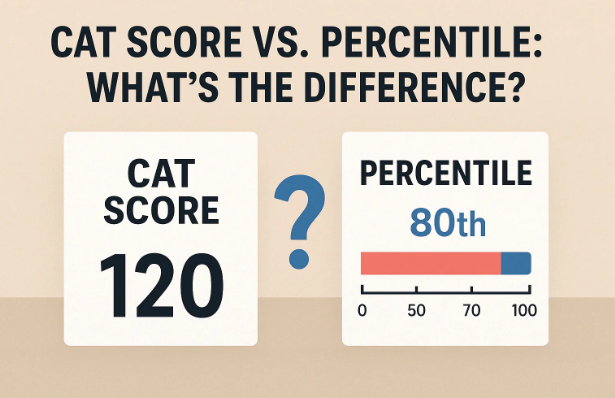CAT Score vs Percentile: Understand the Difference, Decode Your Result, and Plan Smarter

Understanding CAT score vs percentile helps you read your result correctly. First, your score shows how many marks you earned after the official marking scheme. Next, your percentile shows where you stand compared to other test takers. Consequently, both metrics matter, yet they answer different questions.
Moreover, the score reflects your absolute performance on the paper. However, the percentile captures your relative position in the tested population. Therefore, two people with the same score can hold different percentiles across different slots. Because competitiveness shifts by slot, percentiles shift as well.
Additionally, admissions committees scan percentiles faster because they compare candidates quickly. Yet they still examine section-wise performance. Therefore, treat the overall number as a quick signal and the sectional numbers as depth checks. Consequently, learning the mechanics behind CAT score vs percentile gives you an admissions advantage.
How Raw Score Becomes Scaled Score
First, you attempt questions and accumulate a raw score using the marking scheme. Then, the exam authority normalizes raw scores across slots. Consequently, a scaled score emerges that adjusts for slot difficulty. Therefore, the scaled score becomes the base for percentile calculations and comparisons.
Additionally, normalization safeguards fairness when multiple sessions differ slightly in difficulty. Because small variations occur, scaled scores correct the playing field. Therefore, you should not compare raw scores across slots directly. Instead, you should compare scaled scores to understand your relative standing better.
Furthermore, candidates often worry when scaled scores deviate from raw totals. However, variation simply reflects the statistical normalization process. Consequently, keep focus on accuracy and attempt selection. Therefore, invest in question triage, steady pacing, and error control to maximize the scaled outcome across all sections.
How Percentile Is Calculated
Percentile answers a simple question: what percentage of candidates scored below you. Consequently, if you outperform most test takers, your percentile rises. Therefore, even small score gains can significantly move your percentile near the top, where the competition bunches tightly and every mark counts more.
Additionally, percentiles derive from scaled scores, not raw scores. Because normalization comes first, percentile calculations happen on an equalized scale. Therefore, sectional percentiles and overall percentiles may not align perfectly. Consequently, strong balance across sections usually drives a higher overall percentile consistently and reliably.
Moreover, percentiles distribute unevenly at the top. Because many candidates cluster around similar scaled scores, minor improvements create large jumps. Therefore, late-stage accuracy work and smarter question selection deliver outsized returns. Consequently, tracking sectional weak spots weekly often boosts percentile faster than chasing risky speed gains.
Why Percentile Can Look Higher Than Your Score
Sometimes your scaled score appears modest, yet the percentile looks impressive. Because percentile is relative, a tough paper lowers everyone’s scores. Therefore, your position can still be high. Consequently, never judge performance with scores alone. Always pair the metric with its matching percentile in context.
Additionally, a balanced profile can lift overall percentile beyond expectations. Because many candidates spike in one section and drop in another, steady section-wise performance wins. Therefore, you should protect your lowest section first. Consequently, raising the floor increases overall stability and improves CAT score vs percentile alignment.
Moreover, distribution dynamics matter near cutoffs. Because most candidates cluster around sectional thresholds, clearing them with margin helps. Therefore, add two or three guaranteed accuracy questions in your weakest section. Consequently, those marks push your scaled score higher and unlock a disproportionate percentile jump immediately.
Interpreting CAT Score vs Percentile for Shortlisting
Admissions teams need fast, fair comparisons. Consequently, they rely on percentiles to screen large volumes efficiently. Therefore, the overall percentile often drives the first shortlist. However, section-wise percentiles remain crucial where institutes enforce minimum sectional cutoffs to ensure balanced aptitude across quantitative, verbal, and data interpretation.
Additionally, schools evaluate consistency and readiness. Because erratic sectional performance signals fragility, balanced percentiles reassure selectors. Therefore, aim for sectional cushions above typical thresholds to de-risk shortlist stages. Consequently, design mocks that mirror the official format and track percentile projections, not just raw or scaled point totals.
Moreover, remember qualitative fit. Because interviews assess communication, clarity, and intent, your file must tell a coherent story. Therefore, pair strong percentiles with evidence of learning agility and teamwork. Consequently, a sharp Statement of Purpose and precise answers about goals convert percentiles into admits more reliably.
Strategy: Move Percentile by Targeting Sections
Start by isolating your weakest section through granular error logs. Because accuracy compounds, fix question selection first. Therefore, build a “no-regret” set of problems you always nail. Consequently, anchor early confidence, reduce negative marking risk, and raise your scaled score predictably across multiple test slots.
Additionally, chase “conversion pockets” where accuracy improves fastest. Because certain question types reward method over speed, prioritize them. Therefore, create ten-minute micro-drills with timed checkpoints and instant review. Consequently, you will lift accuracy, preserve energy, and protect time for higher-yield problems later in the section.
Moreover, simulate pressure. Because percentile spikes occur near the top, practice finishing strong. Therefore, insert late-section sprints with strict attempt caps and penalty audits. Consequently, you will avoid desperate guessing, minimize unforced errors, and lock incremental scaled points that shift CAT score vs percentile meaningfully upward.
Common Myths About CAT Score vs Percentile
One common myth says a fixed score always equals a fixed percentile. However, distribution changes by slot and cohort. Therefore, a single “magic number” does not exist. Consequently, focus on test-day execution, not internet benchmarks, and track percentiles using scaled performance across repeated, standardized mock environments.
Another myth claims speed alone drives percentile. However, accuracy decides scaled scores under negative marking. Therefore, reckless attempts drain your position quickly. Consequently, limit attempts to high-conviction questions, enforce review rituals, and cut experimental guesses unless time, pattern familiarity, and elimination certainty align clearly and consistently for you.
A third myth suggests sectional weaknesses can be masked by a stellar overall. However, sectional cutoffs block that route. Therefore, systematic floor-raising matters more than raw ambition. Consequently, design weekly cycles where the weakest section receives the most attention, the strongest section maintains form, and the middle section steadily climbs.
Conclusion
Ultimately, mastering CAT score vs percentile means thinking in absolutes and relatives together. Because scaled scores show precision and percentiles show position, you must optimize both. Therefore, build accuracy first, protect sectional floors, and practice like the final. Consequently, take charge now and elevate your shortlist chances confidently.
FAQs
What is the core difference between CAT score and percentile?
Your score shows marks earned after the official marking scheme and normalization. Meanwhile, your percentile shows the percentage of candidates below you on the scaled distribution. Therefore, the score measures absolute performance, while the percentile measures relative standing required for quick, fair comparisons during shortlisting.
Can two candidates with the same score get different percentiles?
Yes, distribution and slot normalization affect relative positions. Because different sessions vary slightly in difficulty, scaled scores may align while surrounding distributions differ. Therefore, percentiles can diverge. Consequently, final positions depend on how many test takers cluster above or below each scaled score point on test day.
Why do minor score gains cause large percentile jumps near the top?
Top ranges are crowded. Because many candidates sit within a narrow band, small accuracy gains shift your rank noticeably. Therefore, each additional correct answer can move your percentile more than you expect. Consequently, targeted accuracy work often beats risky speed pushes in the final preparation stretch.
How should I balance sectional and overall preparation for shortlists?
Protect sectional floors first. Because institutes often enforce minimum cutoffs, stable sectional percentiles prevent early rejection. Therefore, schedule extra time for your weakest section, maintain form in your strongest, and grow the middle. Consequently, the overall percentile climbs steadily while your shortlist risk drops meaningfully.
What practical steps improve CAT score vs percentile quickly?
Start with question selection discipline and negative marking control. Because accuracy drives scaled points, trim low-conviction attempts. Therefore, drill high-yield patterns, add late-section execution sprints, and analyze error logs weekly. Consequently, you will raise scaled scores, unlock percentile jumps, and strengthen your admissions outlook efficiently.



